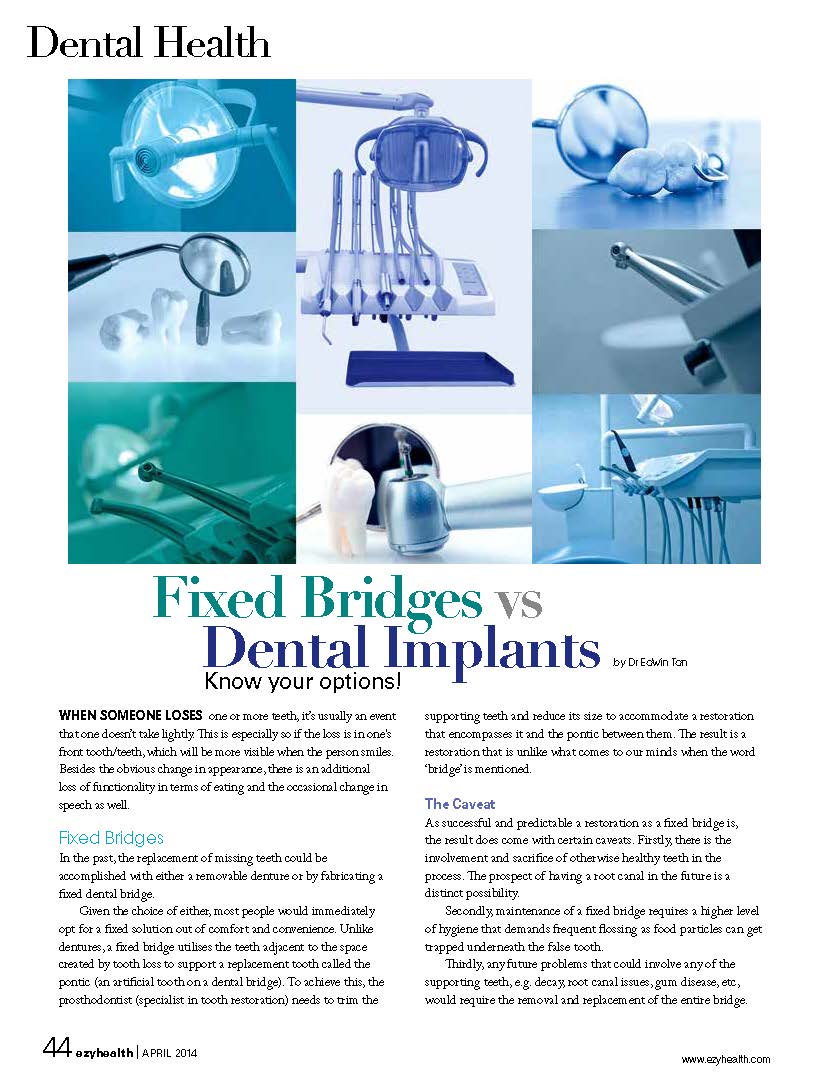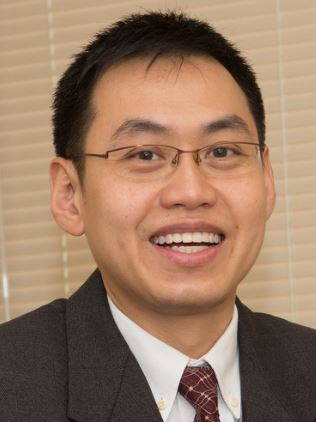This article first appeared in the April 2014 issue of Ezyhealth magazine. We have reproduced it for the information of those of you who missed it when it was published.
When someone loses one or more teeth, it’s usually an event that one doesn’t take lightly. This is especially so if the loss is in one’s front tooth/teeth, which will be more visible when the person smiles. Besides the obvious change in appearance, there is an additional loss of functionality in terms of eating and the occasional change in speech as well.
Fixed Bridges
In the past, the replacement of missing teeth could be accomplished with either a removable denture or by fabricating a fixed dental bridge.
Given the choice of either, most people would immediately opt for a fixed solution out of comfort and convenience. Unlike dentures, a fixed bridge utilizes the teeth adjacent to the space created by tooth loss to support a replacement tooth called the pontic (an artificial tooth on a dental bridge).
To achieve this, the Prosthodontist (Specialist in Tooth Restoration) needs to trim the supporting teeth and reduce its size to accommodate a restoration that encompasses it and the pontic between them. The result is a restoration that is unlike what comes to our minds when the word “bridge” is mentioned.
The Caveat
As successful and predictable a restoration as a fixed bridge is, the result does come with certain caveats. Firstly, there is the involvement and sacrifice of otherwise healthy teeth in the process. The prospect of having a root canal in the future is a distinct possibility.
Secondly, maintenance of a fixed bridge requires a higher level of hygiene that demands frequent flossing underneath the false tooth as food particles can get trapped underneath the false tooth.
Thirdly, any future problems that could involve any of the supporting teeth e.g. decay, root canal issues, gum disease etc, would require the removal and replacement of the entire bridge.
Dental Implants
With the advent of dental implants in mainstream dentistry, the consequences of having a fixed bridge have been greatly reduced. By simply replacing the missing teeth without the need to utilise the neighbouring ones, we are able to preserve the integrity and structure of the teeth that were previously sacrificed to accommodate the bridge.
With careful X-ray imaging and planning, the dentist has the capability to place dental implants in a manner that allows it to occupy the position of the tooth that was lost. Even in situations where more than one tooth is missing, the Prosthodontist has the option of either replacing the space with a “one implant per tooth” solution or a fully supported implant bridge which is basically a bridge design supported solely by implants.
The Drawback
There are times that underlying deficiencies resulting from long term tooth loss could delay or exclude the patient from receiving an implant immediately. These scenarios would include situations when there is not enough bone volume or when there are pre-existing conditions such as badly broken down teeth or infections on the site where implants are planned. In such situations, other forms of treatment like bone grafting or root planning may be necessary, prior to having implants based restorations.
Seek Expert Opinions
Ultimately, traditional tooth borne bridges are still a viable choice in some situations, however, dental implants now offer the possibility of having natural, comfortable and stable long term teeth replacements without the need for further tooth destruction.
Does it mean every patient that presents with missing teeth can have dental implants? Are implants the panacea for all tooth loss? Simply put, the decision to proceed with either option should be made after seeking the expert opinion of a Prosthodontist and his surgical team. Consult your Prosthodontist and embark on the first step towards restoring your oral health and function.
Dr. Edwin Tan is a Dental Specialist in Prosthodontics with Specialist Dental Group®. He is also a Senior Adjunct Lecturer with the Department of Restorative Dentistry at the National University of Singapore. Dr Tan has a special interest in dental implants, crowns and aesthetic dentistry. For more information, visit www.specialistdentalgroup.com.







